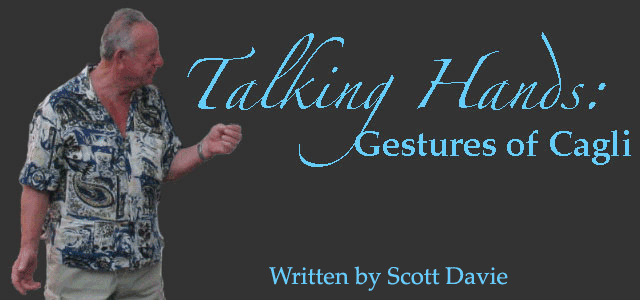

There's
an old saying about Italians, "If you tie an Italian's hands behind his
back, he becomes mute."
This observation is no more evident than in the small mountain town of
Cagli, Italy. All day, Italian hands can be seen gesturing: complimenting,
accentuating, and explaining the speech flowing from their mouths. Some
gestures appear frantic, emphasizing each word so that the meaning is
even clearer to the listener. Other gestures are fleeting, offered in
passing, used as a nonchalant greeting, goodbye, or to punctuate a quick
statement, like, "No really, florescent capris look fine." An Italian's
hands perform a dance: almost simple, sometimes graceful, sometimes crude,
sometimes confusing, but always with a purpose behind it as important
as that of an orchestra conductor.
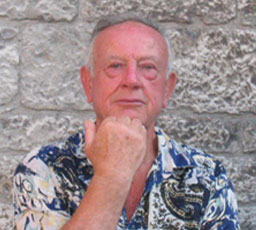
Roll over the picture to see a Cagliese man demonstrate the expression for "I don't care."
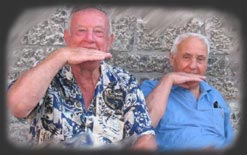
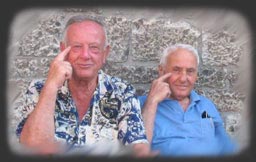
Above: Two wallsitters bite their hands to express dislike. Right: A point on the head means crazy.
"In
Italy, there are many different ways to say the same thing with your hands,"
according to Gabriella Mansi, a translator in Cagli. "It just depends
on the person." The difference in everyday conversation between the U.S.
and Italy becomes strikingly clear through just a few observations.
Much like conducting an orchestra, hand motions have to go along to the
music, the conversation. Otherwise, it can disrupt the flow, and the horn
section becomes annoyed at you. The first swells of music in the conversation
stem from a greeting. In the Piazza di Matteoti, various hand signs can
be seen as the Cagliese people greet each other. While passing by the
fountain that graces the center of the piazza, two barely acquainted folks
will offer a "Ciao," followed by a quick wave. So far, this is no different
than in America, the same song structure.
Along those lines, casual acquaintances stop to shake hands or exchange
a quick peck on the cheek before starting a brief conversation, perhaps
about florescent capris. However, friends or family meeting each other
in Cafè D'Italia or some other Cagli establishment would extend those
same gestures further, with two kisses on either cheek, or, for a woman,
a quick kiss of the hand. A common American misconception with both of
these greeting s is that the lips are supposed to touch the person. However,
the kisses are merely to grace the air near the skin, for if they touch,
it is a sign of disrespect. The older gentlemen who grace the front of
the Cagli town hall every evening corroborated this.
Flash to Cafè del Corso, a retro New York City type bar, with the same two teens sitting down enjoying a drink. To Claudio's dismay, his arch nemesis, Franco, strolls in. With a quick bite of the hand and a point, Fabrizio is quickly and effectively informed of Claudio's dislike for Franco. If Claudio wanted to convey that he thought that Franco was crazy, a couple quick taps to the side of the head would do. Or, vice versa, if he wanted to convey that Franco was smart, drilling the side of the head would express that thought. Now, the musical piece is fleshing itself out, becoming one with the conductor, the motions.
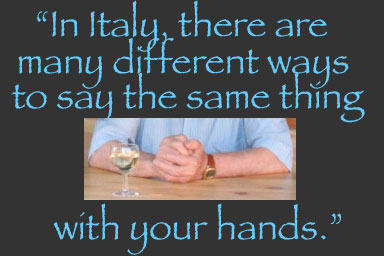

Most
of the hand motions in Italy are conducted face-to-face, as would be expected,
and there are a wide variety of gestures in many diverse situations. Imagine
a basketball game in Cagli. The mountains provide a pleasant backdrop
to a contest of lay-ups and jump shots, jukes and crossovers. After a
hard fought match, one team ends up victorious. To show their happiness,
two players raise both hands over their heads in a fist and pump it up
and down. Two other players raise their arms up and make a "V" with their
middle finger and index finger. Both gestures represent victory in Italian
culture, which is odd, considering in the U.S., the "V" universally symbolizes
peace.
Another face-to-face situation one might get into is after a delicious
meal. After enjoying some delectable tortellini at Ristorante Pigli in
Cagli, a woman-Catalina for the purposes of this article-might first turn
her finger into her cheek, showing that the meal was good. Next, Catalina
could rub her hands together expressing more satisfaction, followed by
a quick kiss of the tips of her fingers.
When
it comes to insults, it seems Italy has a plethora of signs to tell people
off. Let's say Catalina and Claudio get into an argument about Claudio's
florescent capris. Catalina thinks they are awful, while Claudio insists
they're the latest rage. The conversation gets quite heated, so Claudio
raises his hand as if to say, "What do you want from me?" Look
to the top of the page for example. He then drags the back of his
hand up his chin blatantly, to say to her, "I don't care." In response,
Catalina sticks out her tongue, which in Italy is a less vulgar way to
say, "Screw you." Not exactly the same meaning as in the U.S., where little
kids continually give "raspberries."
Claudio raises his hands in disgust, turns, and spits behind him, to signal
he's ending the conversation on very bad terms, to say the least. The
little spitfire that she is, Catalina then raises her right arm as if
she is flexing, only to bring it into her left arm. For those in the theater
audience, this is the Italian equivalent of the middle finger.
In the U.S., gestures are used all the time, but much more emphasis is
put on what is actually spoken. One could easily get away without using
hands when speaking. Not in Cagli or Italy, however; the hands denote
much more. "Hands help you speak better," remarked a man in broken English
outside the looming town hall, his arms waving (he refused to give his
name). The men on either side of him both nod after he repeats the sentence
in Italian. "It just more easy." Even when an Italian speaks on a telephone,
the hands are always in constant motion, helping along the invisible person,
conducting the conversation, making the music flow. The same probably
can be said for the listener on the other end. It goes unnoticed mostly,
because it's so fluid. Only a noisy American would find these motions,
this dance of the hands, interesting.
